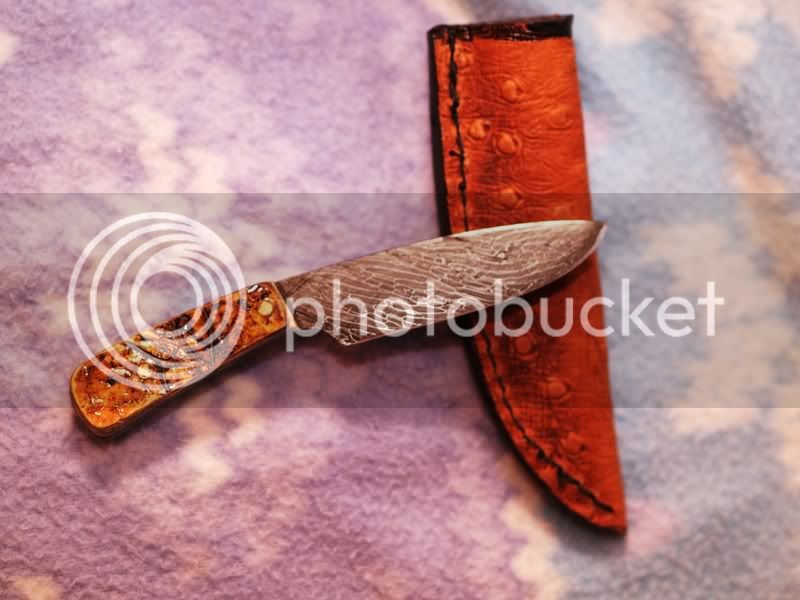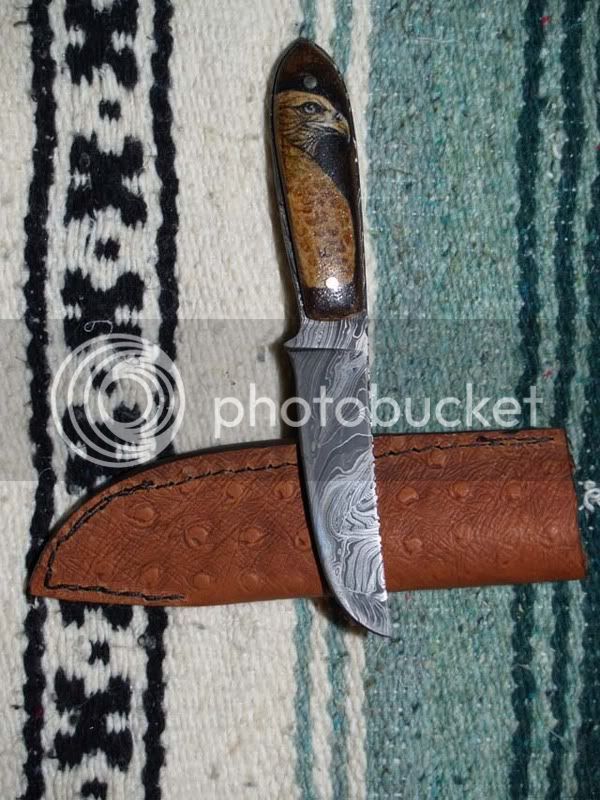-
Friends, our 2nd Amendment rights are always under attack and the NRA has been a constant for decades in helping fight that fight.
We have partnered with the NRA to offer you a discount on membership and Muzzleloading Forum gets a small percentage too of each membership, so you are supporting both the NRA and us.
Use this link to sign up please; https://membership.nra.org/recruiters/join/XR045103
You are using an out of date browser. It may not display this or other websites correctly.
You should upgrade or use an alternative browser.
You should upgrade or use an alternative browser.
New knife---cable Damascus??
- Thread starter fw707
- Start date

Help Support Muzzleloading Forum:
This site may earn a commission from merchant affiliate
links, including eBay, Amazon, and others.
Cable damscus is made by heating a piece of cable to welding temp and twisting it into a tight round billet. The billet is brought back to welding temp and hammer forged to complete the weld.
Once forging, grinding, and heat treating are complete, the blade is etched in acid to bring out the spider web pattern that cable is known for.
Depending on the quality of the cable, and there are several degrees of quality in cable, and the skill of the maker, these knives can be incredibly durable and can take and hold an edge that will easily remove body parts.
Yep, that is one nice knife.
J.D.
Once forging, grinding, and heat treating are complete, the blade is etched in acid to bring out the spider web pattern that cable is known for.
Depending on the quality of the cable, and there are several degrees of quality in cable, and the skill of the maker, these knives can be incredibly durable and can take and hold an edge that will easily remove body parts.
Yep, that is one nice knife.
J.D.
paulvallandigham
Passed On
- Joined
- Jan 9, 2006
- Messages
- 17,537
- Reaction score
- 89
A Piece of steel cable it heated to forging temperature and then forged with a trip hammer to an rectangular-shaped billet, and then is hammered out to the length of the blade. Cut off hardies are generally used to cut away excess metal to create the general form of the knife, and then blade is finished being shaped by with stock reduction or further forging work. Stock reduction is the most common method used today. You can show the " grain " pattern of your damascus steel blade by washing it with vinegar, or by putting mustard on it and leaving it over night. The blade will be blackened by the acids, so you will have to polish the blade back. But the dark areas where the softer steels are located with hold the dark stain, and you will get the contrasting light and dark patterns showing on the blade. Apple cider also works.
The problem with most cables is that they are made from the same steel, and not contrasting wires made of different steels. The cable steel used by knife makers is sometimes different kinds of wire twisted together. The greater the contrasts, the more interesting the pattern.
The problem with most cables is that they are made from the same steel, and not contrasting wires made of different steels. The cable steel used by knife makers is sometimes different kinds of wire twisted together. The greater the contrasts, the more interesting the pattern.
Most people that I know heat the cable to welding heat and twist a coupla times to begin the weld. The round billet is then kinda stuck together, but requires a gentle hand to finish forging or the round billet will "smush" without welding, especially if a power hammer is used to weld the cable.
The cable also needs to be hammered in the direction of the twist to complete the weld in order to prevent separation of the strands and the resultant "smushing" that prevents welding.
Once the billet is welded, a power hammer can be used to flatten and elongate the billet. Preliminary profiling can also be done under the power hammer, as can forming the edge bevel and tang.
Most smiths that I know forge the knife to about 90% shape, including profile, taper, and edge bevel. The blank is now refined by stock removal, both in profile and edge bevel.
After heat treating, the blade is etched in muratic acid, vinegar and mustard don't do a very good job. The acid in the vinegar just isn't strong enough to get the job done.
The etched pattern resembles a spider web where the strands of cable join.
Some smiths do twist strands of various composition of steels to produce an exagerated pattern, but IMHO, it's a lot of extra work for a little benefit, since the real pattern is the spider web effect created by the weld lines joining the various strands of cable.
J.D.
The cable also needs to be hammered in the direction of the twist to complete the weld in order to prevent separation of the strands and the resultant "smushing" that prevents welding.
Once the billet is welded, a power hammer can be used to flatten and elongate the billet. Preliminary profiling can also be done under the power hammer, as can forming the edge bevel and tang.
Most smiths that I know forge the knife to about 90% shape, including profile, taper, and edge bevel. The blank is now refined by stock removal, both in profile and edge bevel.
After heat treating, the blade is etched in muratic acid, vinegar and mustard don't do a very good job. The acid in the vinegar just isn't strong enough to get the job done.
The etched pattern resembles a spider web where the strands of cable join.
Some smiths do twist strands of various composition of steels to produce an exagerated pattern, but IMHO, it's a lot of extra work for a little benefit, since the real pattern is the spider web effect created by the weld lines joining the various strands of cable.
J.D.
First things first, Nice knife. Now on to the cable damascus.
When I make it, I heat it to red heat, untwist it slightly, douse it with a good dose of 20 mule team borax then heat it to a yellow heat and twist the daylights out of it.
After I get a good twist I'll keep heating to a yellow heat and GENTLY tap the billet into a square billet. You can actually feel the billet start to solidify, then you can forge it as usual, hitting it harder with each heat.
After you get it the size you want, just finesse it into a pleasing knife.
To finish you can grind(or file it to a final shape. At this time you want to get it sanded down to about 400 grit. Place it in vinegar, or Ferric chloride (sold at Radio Shack as Archer Etchant). It'll turn black, just was it off with a little soap and water. If you want to make the pattern stand out more, you can blue it with a quality gun blue, then VERY lightly sand it in one direction to bring out the pattern. When it's all done oil it with a good gun oil.
For a variation you can cut and fold it after you have it in a usable billet.
Play a little, you'll be suprised with the result :grin: ...Bud
This isn't a real good photo, but its one I did a while back. the scales a snapping turtle...Bud

When I make it, I heat it to red heat, untwist it slightly, douse it with a good dose of 20 mule team borax then heat it to a yellow heat and twist the daylights out of it.
After I get a good twist I'll keep heating to a yellow heat and GENTLY tap the billet into a square billet. You can actually feel the billet start to solidify, then you can forge it as usual, hitting it harder with each heat.
After you get it the size you want, just finesse it into a pleasing knife.
To finish you can grind(or file it to a final shape. At this time you want to get it sanded down to about 400 grit. Place it in vinegar, or Ferric chloride (sold at Radio Shack as Archer Etchant). It'll turn black, just was it off with a little soap and water. If you want to make the pattern stand out more, you can blue it with a quality gun blue, then VERY lightly sand it in one direction to bring out the pattern. When it's all done oil it with a good gun oil.
For a variation you can cut and fold it after you have it in a usable billet.
Play a little, you'll be suprised with the result :grin: ...Bud
This isn't a real good photo, but its one I did a while back. the scales a snapping turtle...Bud

Nice knife Nifeman! I like it! :grin:
Now about the other blade details ... Isn't the damascus striations on the blade, or any of those types more evident when you apply an acid and etch the blade? Thats is what I have read I have never done it .. :thumbsup:
Davy
Now about the other blade details ... Isn't the damascus striations on the blade, or any of those types more evident when you apply an acid and etch the blade? Thats is what I have read I have never done it .. :thumbsup:
Davy
Guest
Only if it's been acid etched to see the pattern with this type of low contrast Damascus steel when polished out it will look pretty much like any other steel....trodgers said:Damascus? I don't see it...
Maybe its just the resolution on the picture, but shouldn't I be able to see the pattern in the steel? T
The guy who made the knife told me he uses the etching stuff from Radio Shack that Nifeman mentioned, but he ran out and couldn't find anymore.
I tried the vinegar and mustard today, and it made a big difference in the blade. I'm gonna use the acid as soon as I can find some.
I really appreciate all the compliments and information. Y'all are a wealth of knowledge. :hatsoff:
I tried the vinegar and mustard today, and it made a big difference in the blade. I'm gonna use the acid as soon as I can find some.
I really appreciate all the compliments and information. Y'all are a wealth of knowledge. :hatsoff:
Blizzard of '93
Cannon
- Joined
- Oct 3, 2006
- Messages
- 7,237
- Reaction score
- 14
nice patch/skinning blade :thumbsup:
CrackStock
69 Cal.
- Joined
- Dec 23, 2004
- Messages
- 3,017
- Reaction score
- 9
Some people use cheap yellow mustard to mimmick the look of Damascus steel. It does not necessarily give a true color of the pattern Damascus that exists, but rather tracks the thickness of the mustard as it was applied. That is one reason that I like using it at times. I have a number of parts that are not Damascus that look it. I think that Rich Pierce suggested this some time ago and I experimented with it since as I value his input. :hatsoff:
CS
CS
Similar threads
- Replies
- 23
- Views
- 3K
- Replies
- 4
- Views
- 333
- Replies
- 5
- Views
- 454
- Replies
- 5
- Views
- 942
- Replies
- 1
- Views
- 538








